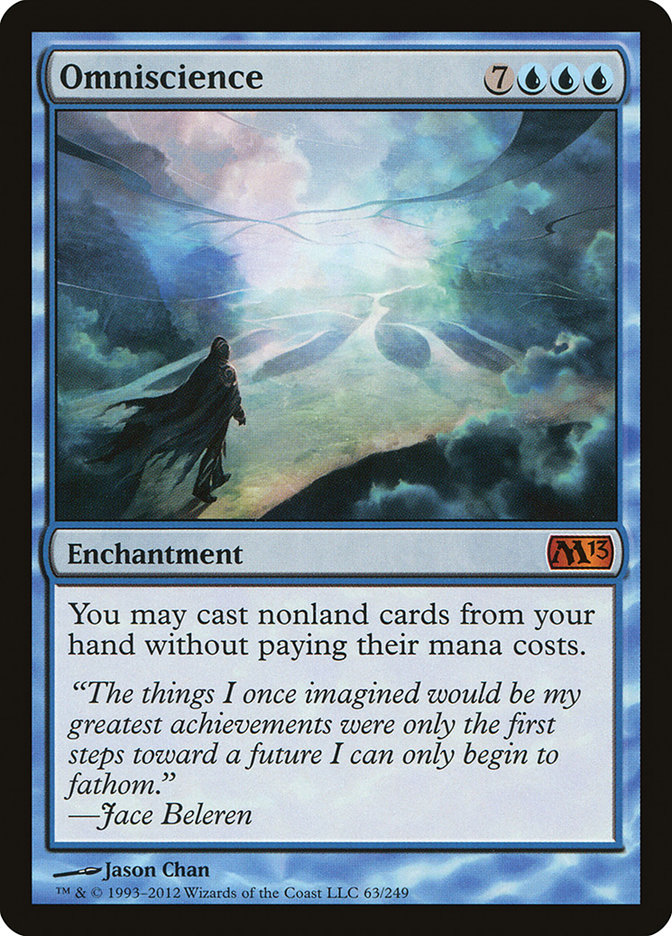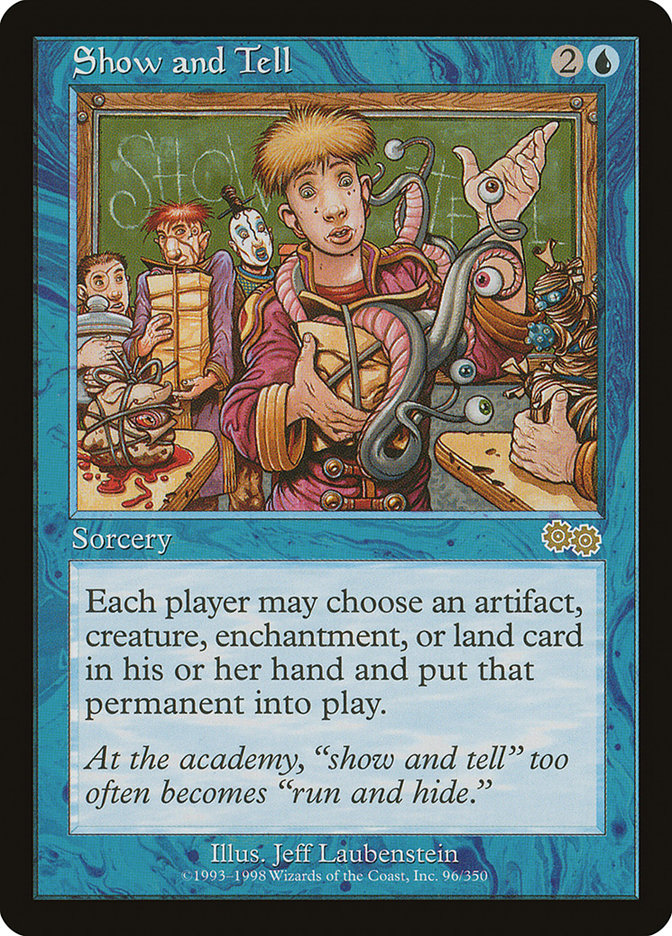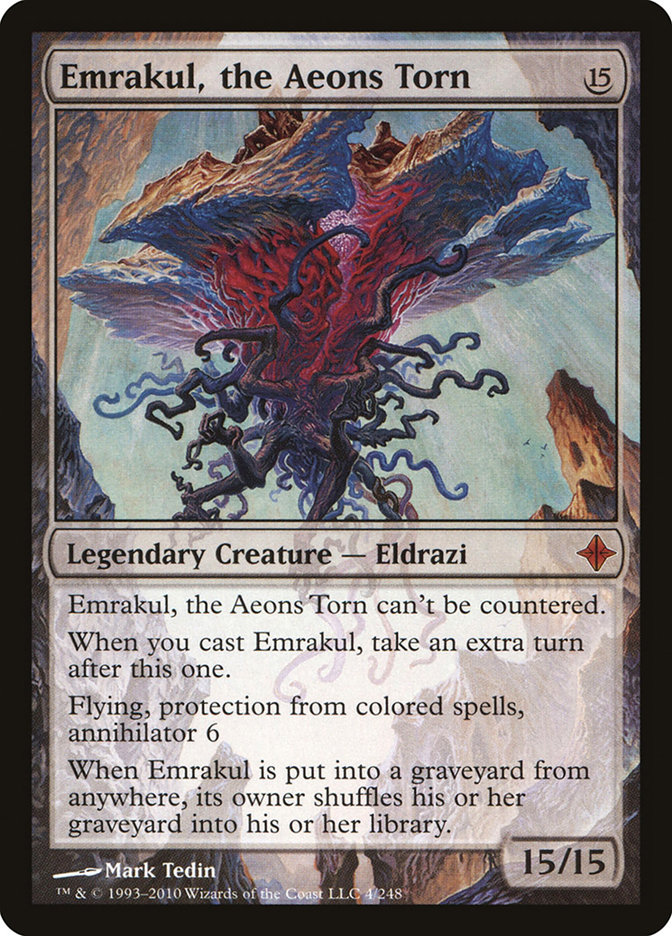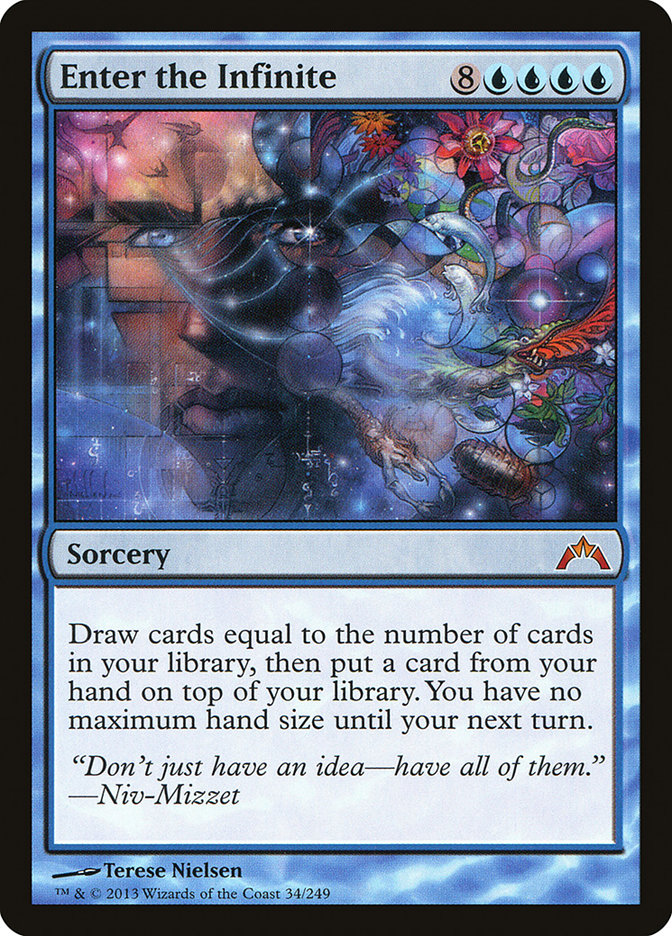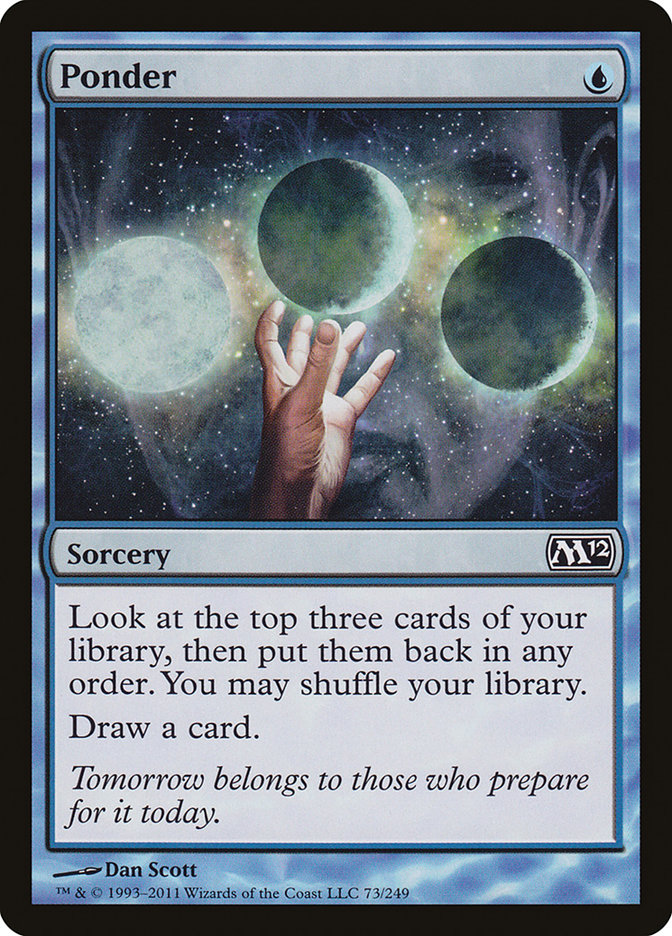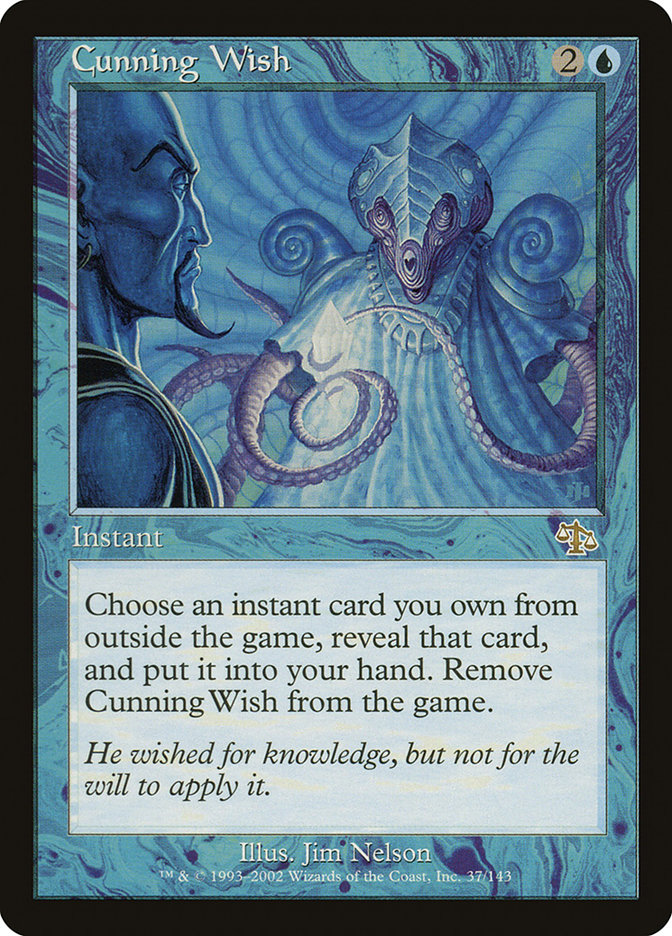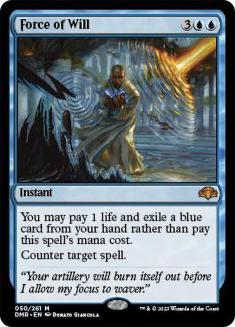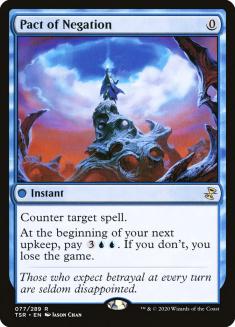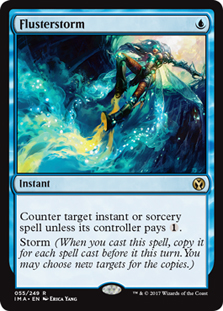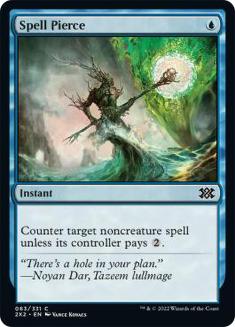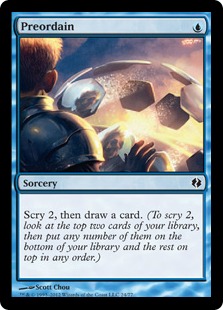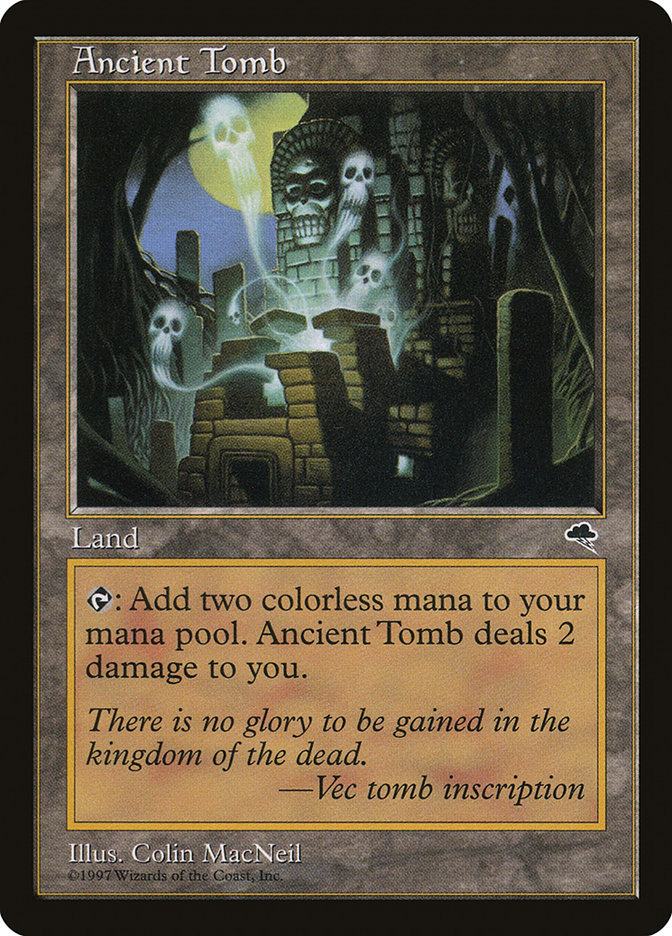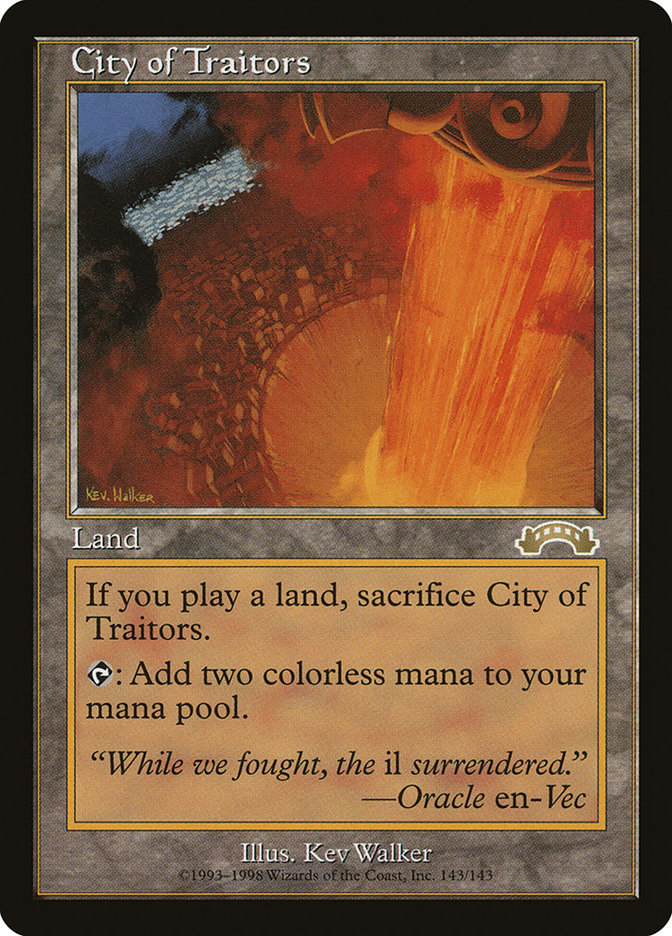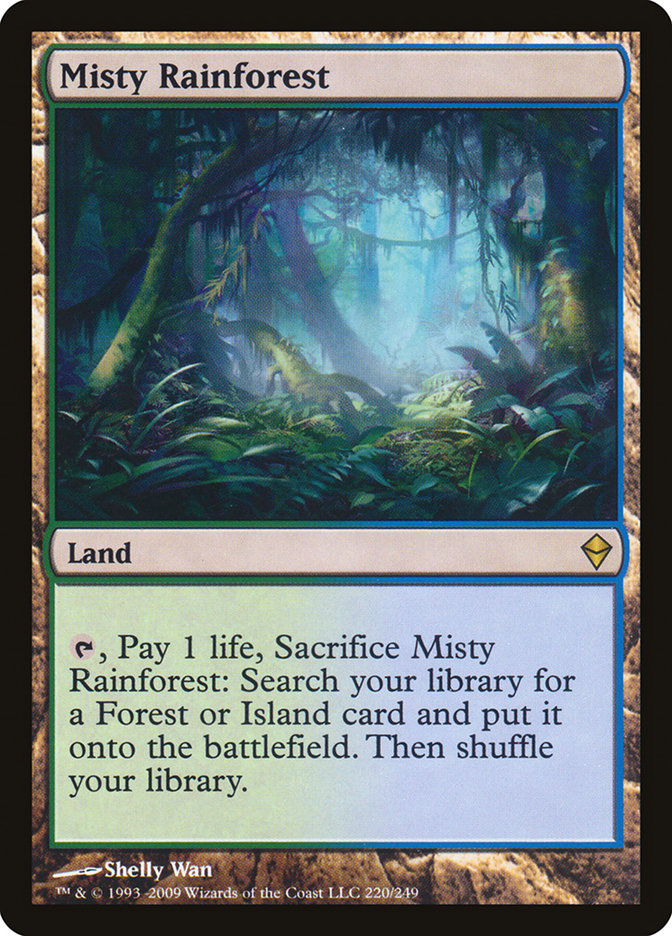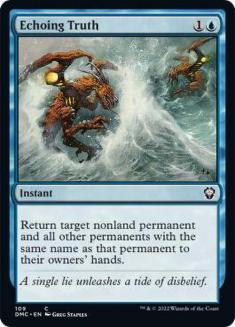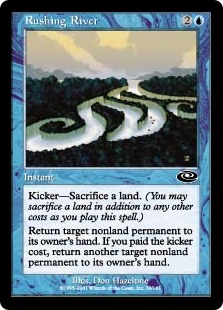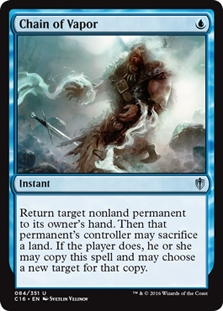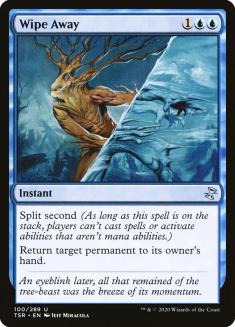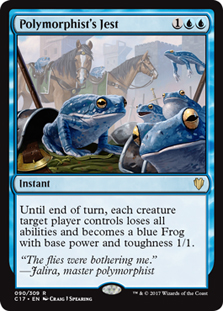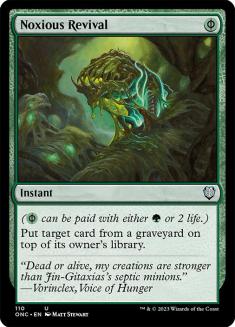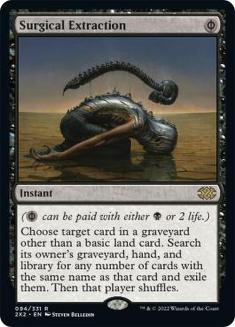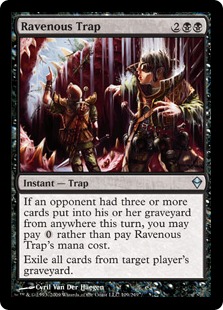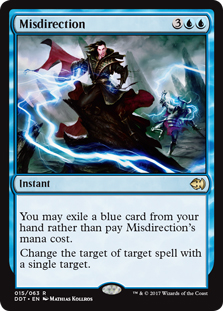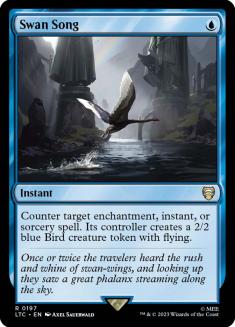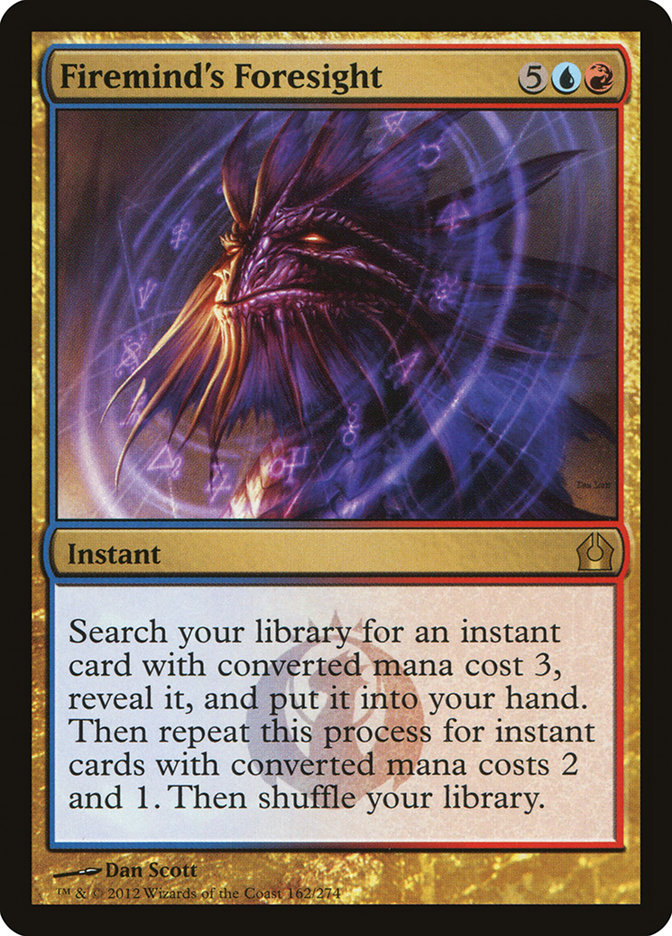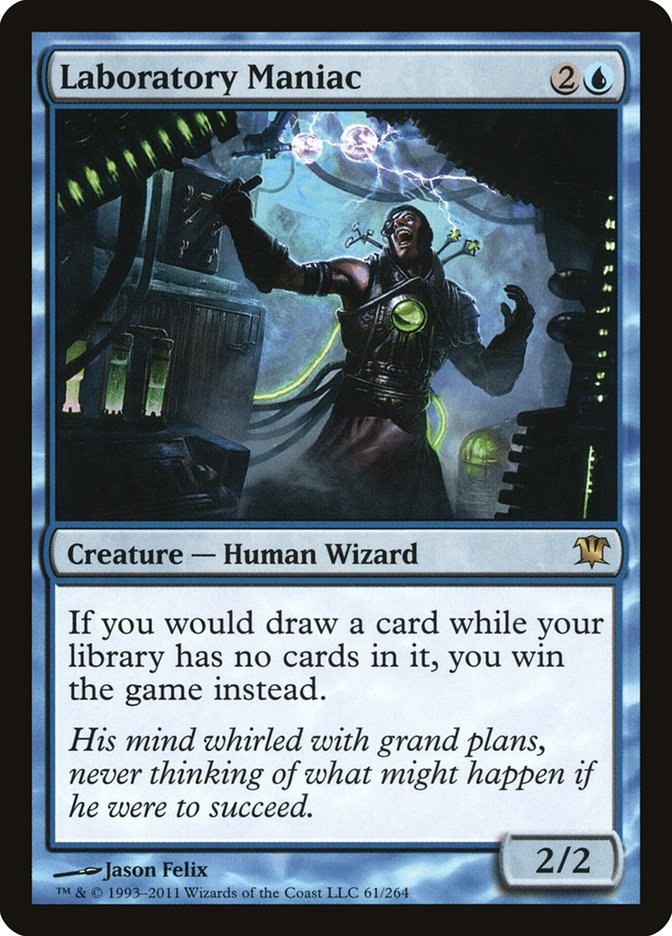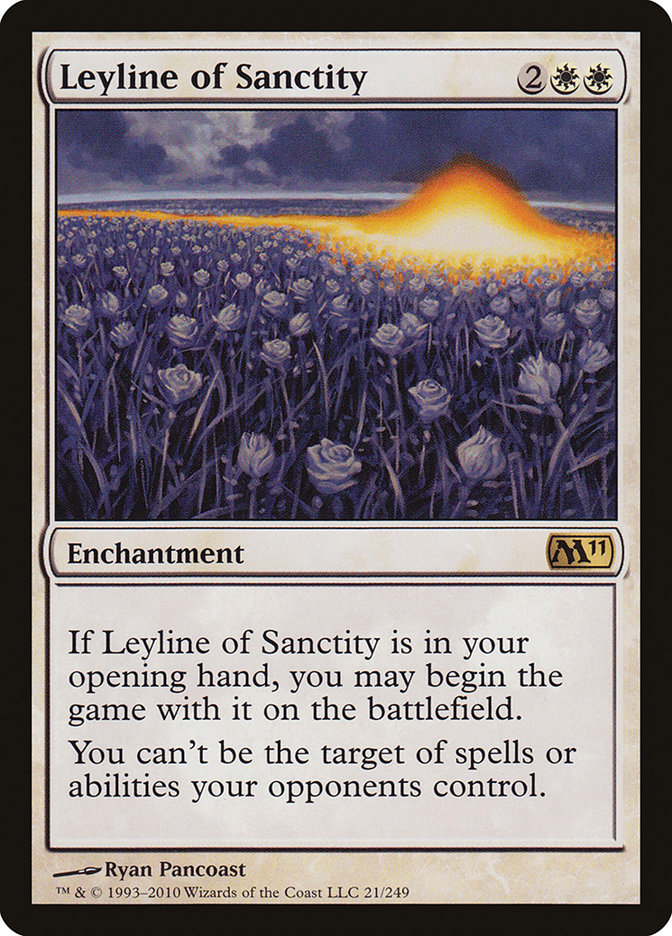Welcome to Infinity!
Omni-Tell is my favorite deck in Legacy, one that is full of huge spells, lots of sequencing play, and is one of the most unfair things you can do in the format. I’ll spare you a big intro, since I know you’re probably wanting to get straight to it, so here goes:
What is Omni-Tell, and what does it do?
At its core. Omni-Tell is (normally) a Mono-Blue Show and Tell-based combo deck, utilizing Show and Tell and Omniscience as the driving force of the deck’s strategy along with cards like Enter the Infinite and Emrakul, the Aeons Torn; huge cards that would be pretty hard to cast normally but require no mana because of Omniscience. Like most blue Legacy combo decks, this deck also features redundant and cheap cantrips, some countermagic, and other ways of finding and defending your combo and its pieces as quickly and efficiently as possible.
The general process of your primary sequence is pretty lengthy but relatively simple once you know what goes where. First, you need to land an Omniscience or Dream Halls, either through Show and Tell or hardcasting. Then you need to get an Enter the Infinite to resolve and put another Enter the Infinite on top of your library as the only card there. After that, you want to cast a Cunning Wish for a Release the Ants, and since you have a card with converted mana cost twelve on top of your library, you’ll usually win the clash, allowing you to repeat this process until your opponent is covered in ants.
Creatures (1)
Lands (20)
Spells (39)

Why should I play this deck?
Because Show and Tell decks are flippin‘ busted in half.
No, seriously.
I’m of the strong belief that Show and Tell is the best mana accelerator in the format. You get to do the most broken thing possible in terms of raw power, and the amount of pressure put on your opponent from the first turn onward is only surpassed by Belcher. As for Omni-Tell as a whole, you’re a combo deck that isn’t too soft to Wasteland and can brute force its way through countermagic and a good chunk of disruption just as well as other Show and Tell decks. You aren’t as vulnerable to hate like Karakas, Pithing Needle, or Phyrexian Revoker, and you can more easily sculpt a gameplan against specific types of hate due to Cunning Wish providing an even further array of tools at your disposal.
Why shouldn’t I play this deck?
There was a time where Show and Tell decks were the most feared decks in the format, in fact, they were so good, that many clamored for the banning of Show and Tell itself.
So, what the heck happened?
Well, players adapted. First, they figured out how to interact with the deck properly. Most Omni-Tell decks are full of so much library manipulation, but all of that manipulation winds up being complete air against repeated and direct disruption backed up by a clock. While this is true for a lot of combo decks, this hurts Omni-Tell much more because it usually needs three pieces instead of two. Secondly, the hate that is good against this deck is completely backbreaking. Cards like Gaddock Teeg, Meddling Mage, Trinisphere, and even common maindeck cards like Liliana of the Veil are so good, that many players have shied away from the deck as a whole. This deck is also not particularly strong against other Show and Tell decks, particularly Griselbrand. Often times, you have to be on the Dream Halls or Show and Tell>Omniscience>Emrakul plan. This plan doesn’t always happen against decks like Reanimator though, since they can disrupt the heck out of you, and just reload.
In short, the deck exposes too many of its pressure points at multiple stages of the game for most players. And as much as I don’t like using the term, there are a lot of cards that are pretty close to unbeatable if you get caught, including Iona, Shield of Emeria, Spirit of the Labyrinth, and Notion Thief.
Why would I play this deck over Sneak and Show?
Well, to be very honest with you, I do believe that Sneak and Show is the more powerful deck heads up. That said, Omni-Tell offers qualities that Sneak and Show can’t give. When your Show and Tell resolves, you are, in most cases in game 1, going to kill them that same turn every time. You’ll often times hear players say that Sneak and Show is a two card combo deck, and in a fair number of cases that’s true. A good portion of the time, however, there are games where you wind up whiffing on Griselbrand, or Emrakul not being enough, or needing Show and Tell into Sneak Attack into Lotus Petal into something else, and even that might not be enough. With Omni-Tell, you’re consenting to a trade-off. You, under optimal circumstances, need an extra card to kill your opponent (Show and Tell, Omniscience, and your kill card, or in more common builds, Dream Halls, blue card, and blue kill card), but when you acquire that card, you’re almost never giving your opponent another turn under normal circumstances. Omni-Tell also has the inherent ability to sidestep a decent amount of hate that other Show and Tell decks have to jump through hoops to get through. Your opponent will be pretty sad when they bring their ineffective Karakas to class, or when your Cunning Wish can answer their instant speed answer for your Omniscience, for example. You also have a pretty large amount of flexibility in your choice of color splashes (if any) and kill cards. This deck is also considerably cheaper than its counterpart. Not everyone is fortunate enough to have access to a Legacy collection, and this is certainly a real factor when considering what deck to invest in.
There is a saying that you shouldn’t play a worse version of something else, and I know it looks like this is the case here. While I’ll probably get called crazy (it wouldn’t be the first time!), I don’t think that’s what’s happening here. We are playing something different, not necessarily better or worse, than Sneak and Show. The decks play differently enough that you can pick and choose which one you like best, and go from there.
The Core: Unless you’re playing a variant, almost all of these cards are locked in.
Disclaimer: all card analyses are made using this build as a reference:
Keyword: Reference.
1 Emrakul, the Aeons Torn: While also being another way of killing your opponent via Omniscience or Show and Tell, the fact that Emrakul is even in your deck makes your Grindstone based matchups much better in game one. Emrakul is also useful when you need to Show and Tell in a pinch; when you don’t have enough resources to go off through Omniscience or Dream Halls, or if you know that they just can’t beat the Emrakul.
4 Omniscience, 4 Show and Tell: This is your nucleus, and is the reason why your deck works. Run four of each, and never look back!
3-4 Enter the Infinite: The most common third piece needed to kill your opponent. This is your Griselbrand essentially, except you have zero chance of whiffing. It’s nothing more than Force of Will fodder if you aren’t going off, so there is some merit to playing three. A counter-argument to they would be how much easier it makes shipping cards with Preordain and shuffling away with Brainstorm + shuffle effect. Regardless, Enter the Infinite is the bridge that gets you from one side of your combo kill to the other.
4 Brainstorm, 4 Ponder: Like most blue decks, you’re going to play four Brainstorm. It’s the best card in Legacy, and AJ Sacher would kill me if I even so much as thought about thinking about playing less than the maximum allowed. Ponder is also an easy inclusion because of how efficient it is at getting you to what you need to get to, and I’d probably get chastised for even considering less than four of these as well.
3-4 Cunning Wish: This is your key to your toolbox. Having Cunning Wish is pretty strong at most points in the game, before and during comboing off. You’re able to respond to anything trying to wedge your mid-combo process, get an answer to one or more specific things preventing you from comboing, or just use it as a piece of soft or hard countermagic. How many you run is totally up to preference, but consider running less than four if you decide to play any number of Intuition in your maindeck. As having multiples of both Cunning Wish and Intuition can get pretty clunky pretty fast.
3-4 Dream Halls: the most common secondary win condition. Dream Halls isn’t the most efficient option out there, and there are certainly times where it can backfire, but it’s the best explored option available (more on this later), and it’s certainly the cheapest. This card is primarily the reason why you’re so restricted on what non-blue cards you can play (Force of Will being a distant secondary reason), so your hands are a little tied in the deckbuilding process, but again, your options are pretty low here.
4-6 pieces of countermagic (Force of Will, Pact of Negation, Flusterstorm, Spell Pierce):
Now, I would normally say that you can just jam four Force of Will in any other deck and call it a day. However, Omni-Tell behaves in such a way that Force of Will isn’t always a great first choice when protecting your combo. As previously stated, you’re a three card combo deck without Dream Halls, and can often be a four or five card combo with Dream Halls, and Force of Will can really put a strain on things if you have to pitch that crucial blue card that wins you the game. A stock Omni-Tell deck usually runs the full set of Force of Will and up to two copies of Pact of Negation, but there are other configurations (see Variants section). Alternatively, you can put one of the Forces in the sideboard for Wishing or space purposes.
0-4 Preordain: Preordain is another insanely efficient digging tool, but is slightly weaker than Ponder, and is the first cut you can make if you’re deciding to add other role-players to your deck.
4-6 Sol lands (Ancient Tomb, City of Traitors): your Sol land count and split is entirely up to you and your preference. Ancient Tomb gets to stick around indefinitely, but the two damage per turn is certainly a thing against decks trying to attack with creatures. This is especially harmful against Delver of Secrets and Thalia, Guardian of Thraben decks, as they can really stress out your resources with Wasteland, countermagic, and Thorn of Amethyst effects. City of Traitors doesn’t have most of the drawbacks of Ancient Tomb but often counts as less than a land when you’re already strapped on resources. The drawback can hurt you way more than Ancient Tomb in many situations, often resembling an “all-in” style of land. Once you put this land down, you’re usually saying that you’re going for something big that turn or next turn.
6-7 fetch lands, 6-7 Islands: Now, on the surface, it doesn’t really matter which blue fetches you use, as all of them get the job done equally. However, let’s say that we have access to all of them, then we can truly min/max here. When I approach Omni-Tell manabases, I tend to ask myself a number of questions, one of which includes: “what fetch land configuration gets the most heat off my back in the early game? Flooded Strand into Island can imply that I’m on something like Miracles, while Misty Rainforest can imply U/R, RUG or BUG Delver. Polluted Delta, while there is a chance they could put you on any BUG deck or Deathblade, can also raise some red flags because of Reanimator, and Scalding Tarn is the “I should put my guard up just in case!” Fetch land, because Sneak and Show is one of the most, if not the most popular unfair Scalding Tarn deck. Basically, I’m looking to try and look as “fair” as possible to my opponent on turn 1. You may ask if this is even worth doing, but when you think about the potential Ponders and Brainstorms that can change because of that small chance of your opponent putting you on a fair deck, it becomes more attractive when it’s available to you. It’s not wrong to ignore this option, and I don’t want you to think that it’s sub-optimal to not do it, but do consider it if you can.
Outside of your fetch lands, your basic islands are essential to your manabase’s resiliency to Wasteland. Keeping the number over six is recommended.
Sideboard and “Wish-Board” Options: your sideboard is mostly an extension of your maindeck, and it’s very important to have your board set up to deal with almost any amount of hate.
A standard Cunning Wish package will include, but will not be limited to:
1-2 bounce/removal effects: ways to get rid of permanent-based hate.
Echoing Truth: Most applicable against multiple Meddling Mages, Oblivion Ring-style effects, and situations where you’re strapped on mana.
Wipe Away: Best against Miracles, opposing countermagic, and Mother of Runes.
Rushing River: Choose this if you want to have the most overall coverage. Ineffective against Mother of Runes, but your second bounce spell should be able to cover that angle.
Polymorphist’s Jest: From M15 comes an incredibly useful tool that functions as a straight up Evacuation against any creature based hate. Ineffective against non-creature permanent based hate.
Slaughter Pact: Honorary “bounce” spell, and your cheapest option when looking to get through hate before going off (Ruric Thar, the Unbowed can create situations like this).
1-2 pieces of graveyard hate: Not many options here, but a couple of them have other roles in addition to spiking a graveyard.
Noxious Revival: your most versatile form of graveyard hate, mostly because of how good it is at getting you out of corner case situations. Will save your butt against Reanimator and can help a lot against anything trying to hit you with Surgical Extraction type effects. If you somehow wind up decking yourself after Entering the Infinite, or messing up with a Laboratory Maniac kill, you can save yourself with this as well.
Surgical Extraction: Great because it’s “free” but also effective against Life from the Loam strategies and arguably better against Reanimator. Pretty poor against Dredge.
Ravenous Trap: your best option against Dredge style decks, but pretty clunky everywhere else.
Additional countermagic: counterspells that can function as real sideboard cards in certain matchups, taking a more utilitarian function.
Flusterstorm: Great to have when sitting on four mana with a Cunning Wish in hand against Storm, and great to board in against it, and discard on the play, among many other threatening instants and sorceries.
Pact of Negation: Your go to counterspell when something tries to hit your Omniscience in response to your Enter the Infinite, mostly because it’s zero mana and unconditional.
Force of Will: Playing a three to one split of maindeck and sideboard Forces is a great option when trying to expand your Cunning Wish options, especially when playing four wishes.
Spell Pierce: generally weaker than the other options listed, but a huge selling point of this card is the ability to hit Liliana of the Veil, an absolute house against us.
Swan Song: great against Miracles and heavy countermagic decks, but kind of awkward against Delver, and can pose an issue if you wind up getting disrupted hard enough. Still a strong choice if you want a bit more versatility.
Misdirection: the more Hymn to Tourach, Fireblasts, Ancestral Visions, and other ridiculously heavy impact for cheap targeted spells you expect, the better this becomes.
Other utility spells: cards that fulfill very specific roles and aren’t dedicated toward much else but still very important.
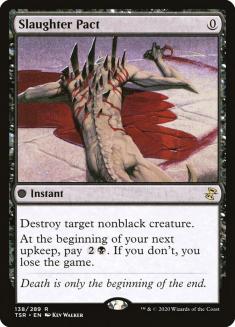
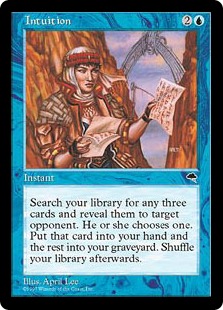
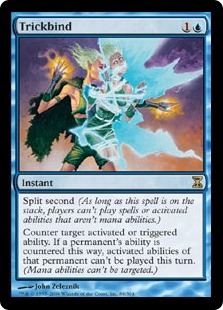
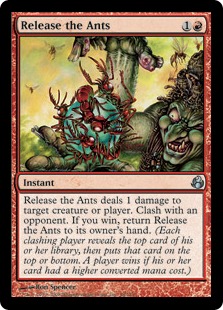
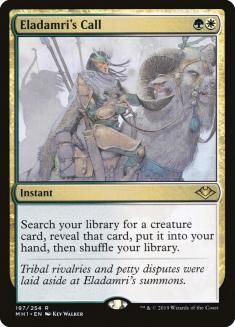
Slaughter Pact: One of your only outs to Iona, Shield of Emeria, and other problematic creatures that your blue bounce spells can’t deal with.
Intuition: Another route to victory via Cunning Wish and also an effective (though rather slow) way to get to a piece that you may need. Even without the soon to be talked about Firemind’s Foresight package, you’re going to want this to cover that angle.
Trickbind: a staple in all sideboards. Trickbind is the reason why you get through cards that try to disrupt you at the earliest vulnerable point of your combo sequence, which is after your Omniscience or Dream Halls sticks, but before your Enter the Infinite resolves.
Release the Ants: Your go to (and actual) win condition after all of your Enter the Infinite shenanigans happen and the dust settles. You should almost always win the clash against your opponent with this card (since you’re usually putting Enter the Infinite on top of your library)
Eladamri’s Call: When up against Hatebears, this is the quickest way you can get to your Emrakul, which is the more reliable way to get them dead.
The Firemind’s Foresight package:
Firemind’s Foresight is a pretty unique card in its own right, but its application in this deck may surpass the uniqueness of the card itself. Firemind’s Foresight allows you to win the game under a very specific set of conditions, in a way that you otherwise couldn’t with any other instant speed card in Magic. Now, before anything, you must have a two drop instant card, and an Intuition in your maindeck for this to work. The more popular two drop instant is Impulse, but Trickbind is another fine option. Firemind’s Foresight becomes your game winning play under these conditions:
– A Dream Halls on the battlefield
– Three blue cards in your hand, one of which is Cunning Wish, and none of them being Enter the Infinite or Omniscience. (If any of them are then you don’t need to take this line to win)
– Your Intuition and two drop instant still in your library
The line goes like this: you discard one of your blue cards to cast Cunning Wish (3-2=1), getting Firemind’s Foresight (+1=2), discard your remaining blue card to cast Foresight (-2=0), getting Intuition, CMC 2 instant, and Brainstorm (+3=3), discard one of the non-Intuition blue cards to cast Intuition (-2=1), getting three Enter the Infinites, and taking one of them (+1=2), and finally, discarding the last blue card to cast Enter the Infinite.
Pretty cool, huh?
There are other super corner case scenarios that I can’t think of/have never encountered, but that’s the most common one. Now, this situation will pop up from time to time, and it’s certainly worth considering if you want to cover as many angles of winning as possible. This plan isn’t perfect, however. In the deckbuilding process, this plan takes up a ton of space, requiring two maindeck spots and a sideboard spot. It may not sound like much, but when you’re trying to maximize redundancy as efficiently as possible in your maindeck, and when sideboard space is already extremely valuable because of the nature of wish-boards, adding two fairly clunky and relatively inefficient spells in the maindeck, and a super niche card in the sideboard can be very off putting. Another problem with this package is the situation where you happen to draw your two drop or already use your Intuition. If either of these things happen, then you’re going to have to jump through some serous hoops involving Noxious Revival and an open blue mana, as well as get lucky with your Brainstorm if you’re going to win. Chances of even being in that situation is very low to begin with, so you may be better off just finding another line of play that can win if you have the time and/or resources.
The Laboratory Maniac package:
Now, I don’t have as much experience with this, but from what I understand, the general package includes a Laboratory Maniac, usually in the sideboard, and a sideboarded Research // Development. The sequence (with Omniscience, of course) is as follows: Cunning Wish for Research // Development, the cast the Research half, shuffling in Laboratory Maniac, casting the Maniac, and drawing cards until you can’t draw anymore. The upside to this combo is that you open up a spot in your maindeck (since you don’t need Emrakul with this), and in some cases, is better against some decks or situations. This combo is weaker to some decks as well though (namely miracles and Thalia decks).
The Leyline of Sanctity debate:
Leyline of Sanctity is one of those cards that just seems nuts against what you want it against. It’s been widely accepted as the go-to card when facing anything that plays Thoughtseize, Hymn to Tourach, and the like. Many claim that it buys a large amount of time against Storm as well, and that was once true.
There are a lot more problems with Leyline of Sanctity than benefits, however. You’re pretty much restricted to playing four of them. If you’re trying to play this type of effect, then you’re going to want to maximize it. If you aren’t playing four, aren’t you better off playing actual sideboard cards instead? Additionally, your blue card count goes down significantly, which is relevant for your Force of Will and Dream Halls angles. Drawing one of these blind off of any cantrip is the actual worst, as you can’t do anything at all with them. They take up so much sideboard space for a relatively narrow effect that you have to really ask yourself if it’s worth it at all compared to addressing the real problems with Omni-Tell. Finally, with M15 now released, we now have two extremely important cards that we have to deal with, Void Snare and Reclamation Sage, both of which will see a decent amount of play out of Burning Wish based Storm decks and Elves, respectively. This further weakens the case for Leyline, and while I still think it’s a fine sideboard choice, I think we can do better.
Redundancy: avoiding overlap
Putting together a wish-board is difficult, and making sure you have a tool for every job possible is even more difficult. Since we only have fifteen slots, we have to see that those slots do very specific things, while also making sure that we aren’t already fulfilling that role with another card. For example, I personally prefer to have Polymorphist’s Jest and Rushing River as my “bounce” spells of choice. Polymorphist’s Jest lessens the need for a card like Wipe Away because it already gets through Mother of Runes, which was one of the reasons to play Wipe Away in the first place. Now, say I would want to cover non-creature permanent hate as well. Wipe Away does exactly this, but Rushing River does it better, as it covers two hate cards. The question I would now have to ask myself is if the uncounterability of Wipe Away is worth the rather embarrassing overlap it has with Polymorphist’s Jest. Personally, I don’t think it is, but you may think differently. A similar case can be made with graveyard hate. Noxious Revival has a lot of utility outside of staving off a Reanimate target, but is that Surgical Extraction rotting away because of it? It’s very important to diversify your sideboard as much as possible, even if you wind up missing one of those extreme corner cases. You can’t cover them all, and no matter what decision you wind up making, you’re going to get caught by something! Don’t overcompensate.
“Real” sideboard cards:
You don’t have a lot of room in your board when you already have Cunning Wish to work with, but not all hope is lost. Going the utilitarian route, as mentioned before, opens up a lot of options when going about each matchup. If you decide to take it a step further and cut the Leylines, you’ll then be able to set up a fully modular eight to ten cards worth of adjustments without compromising the integrity of your Cunning Wishes. This is one of the important steps in evolving this archetype (as will be discussed more in depth in the next section).
Defense Grid: At worst, this is a one for one for their counterspells, and can even start a fight early if they’re counter heavy, which is good for you because they get softened up on your critical turn. It can backfire if your hand develops into a counter heavy hand while falling behind though.
Pithing Needle: one of your best tools against Miracles, Liliana of the Veil, and Sneak Attack, and often single-handedly the reason those matchups improve significantly. Most popular Liliana decks pack green as well, and they usually sideboard out Abrupt Decay, furthering the value of Needle, while also hitting Deathrite Shaman if you need to slow them down. Other applications include Aether Vial, Knight of the Reliquary, Grindstone, Mother of Runes, and Helm of Obedience, among many, many others. If you’re going to drop Leyline, this is the card you want.
Boseiju, Who Shelters All: For when you really, really want to stick a Show and Tell or Cunning Wish. Much, much more effective against Miracles and other non-Wasteland blue decks and still decent against Delver but can be slow at times. It is firmly worse than Defense Grid against Delver. The Miracles matchup is a bigger issue than Delver at this time, but you have two good options for what you’re looking for in this and Grid.
Making it better: Other Variants and Options
I think that a big reason why Omni-Tell isn’t as represented is because not nearly as many players play the deck compared to its Sneak and Show counterpart. I think that’s merely a numbers game. There are way more players, many of them notable, that have played, tuned, evolved, and mastered the hell out of the deck over the years. Omni-Tell has had different variants (which will be covered in the next section), but most of them haven’t really made big changes all that much. That isn’t to say that innovations or discoveries haven’t been made, but it’s much harder for us to even know when said discoveries are even happening.
The first thing I want to talk about is some of the previously discussed cards in the “Real” sideboard cards section, and just having a real sideboard in general. I don’t think that we can get away with having all of these hyper-linear cards that are also reactive. Our cards need to be useful in multiple spots, so we don’t wind up twiddling our thumbs as cards like Liliana tick up to seven, or Sensei’s Divining Top takes over a game. Pithing Needle just might be the first step to making forward progress with Omni-Tell, as is Boseiju.
I’ve looked really hard at what Sneak and Show has been doing, and while I know that I’ve been making a lot of back and forth side-comparisons to the two decks, there’s a lot to pick up on. The more we can emulate what our counterpart is doing without losing the focus of our own plan, the more successful we may be.
Another incorporation that I’ve seen out of Sneak and Show is this guy:
One of the biggest reasons to play Jace is because of how much immediate pressure it puts on slower, more grindy decks, as well as the Griselbrand combo decks. Landing this on turn 3 makes adding Jace even more attractive, and you begin to promote more proactive gameplay as opposed to flimsy cantripping and lack of options. This also makes Lotus Petal a bit better, as you can just have a turbo plan with this newfound bridge in between your Show and Tell and Dream Halls (though your blue card count needs to be kept high). Remember when I said that Preordain would be the first cut when making major changes? As much is it sucks to see it go, I think it’s best for business, especially when looking at what you wind up with:
Creatures (1)
Planeswalkers (2)
Lands (19)
Spells (38)

If you aren’t comfortable with the loss of Preordain, and/or you aren’t a fan of Lotus Petal, then Sensei’s Divining Top may be worth it for you. Top is especially strong when playing against discard spells because of how easily you can hide your pieces until you’re ready to use them.
Matchup analyses: (Note: This section’s information can greatly vary, depending on your specific build, and is meant to be used as a very general reference guide to help with your considerations. In short: this is not concrete advice or set in stone in any way, and some cards may not apply if they aren’t in your deck.)
Delver decks: If I had to pick a Delver deck to play against, it’d be RUG Delver, but each of them have specific cards that can be problematic. RUG has Stifle, which can really screw up your Brainstorm sequences. UWR Delver has access to Meddling Mage, which puts a lot of pressure on your Cunning Wish (to get rid of it) and Dream Halls (to get to resolve in the first place). BUG has Liliana of the Veil, and if you’ve been reading up to this point, you know just how insane she is against us. If you have Boseiju, then I wouldn’t mind swapping some Ancient Tombs here. Additional countermagic is also welcome if you have access to them.
Key cards: Daze, Meddling Mage, Liliana of the Veil, Stifle
Cards to consider removing: Preordain, Jace, the Mind Sculptor, Ancient Tomb
Cards to consider adding: Pact of Negation, Boseiju, Who Shelters All, Spell Pierce, Flusterstorm, and Pithing Needle, Defense Grid, Leyline of Sanctity
Sneak and Show: I used to think that this was a good matchup, then after getting thoroughly stomped by Brad Nelson when I first picked up the deck, I figured it wasn’t nearly as good as I thought it was. Now, I think it’s a lot closer with Pithing Needle. Griselbrand vs. Dream Halls is the big factor in this matchup, and Gitaxian Probe is one of the most important cards to have when determining your position. Trickbind is also pretty darn useful when trying to push a Griselbrand out of the way, but they can get around Trickbind with Sneak Attack by holding priority and activating again. Polymorphist’s Jest is also something to consider. The games tend to go long, and it’s all about setting up most of the time, so be prepared to settle in, and don’t rush anything unless you know the coast is clear.
Key cards: Griselbrand, Sneak Attack, Gitaxian Probe
Cards to consider removing: Show and Tell, Force of Will, Preordain, Lotus Petal
Cards to consider adding: Trickbind, Pithing Needle, Polymorphist’s Jest, Defense Grid, Spell Pierce, Swan Song
Miracles: Yet another matchup that Pithing Needle excels in. You’re going to have to jam as hard as possible at as many opportunities as you can find, because Miracles has so many powerful tools against you. It’s not out of the question for the game to get to the point where hardcasting Omniscience can happen. Regardless, this matchup is pretty tough, and you’re going to want to invest all of your resources into pushing through your combo at all points of the game.
Key cards: Vendilion Clique, Counterbalance, Venser, Shaper Savant, Jace, the Mind Sculptor
Cards to consider removing: Preordain, Gitaxian Probe, Force of Will
Cards to consider adding: Pithing Needle, Boseiju, Who Shelters All, Trickbind
Death and Taxes: Thalia is a pain in the side. Thalia and Mother of Runes can be super frustrating to get through. Death and Taxes has the tools to defend against every one of our angles, so it’s on us to get moving and get moving fast.
Key cards: Flickerwisp, Thalia, Guardian of Thraben, Spirit of the Labyrinth, Aether Vial
Cards to consider removing: Pact of Negation, Force of Will, Gitaxian Probe, Jace, the Mind Sculptor
Cards to consider adding: Trickbind, Rushing River, Polymorphist’s Jest, Pithing Needle, Slaughter Pact, Wipe Away
Elves: One of your better matchups, but their sideboard comes packing. Ruric Thar, the Unbowed is a serious problem and will easily destroy you if you aren’t ready to deal with it off of a Show and Tell. Glimpse of Nature and Natural Order are your biggest concerns game 1, and discard coupled with Gaddock Teeg becomes a big deal in games 2 and 3. Reclamation Sage is also a major issue, and can put more stress on your Cunning Wishes.
Key cards: Glimpse of Nature, Green Sun’s Zenith, Natural Order, Gaddock Teeg, Thoughtseize, Cabal Therapy, Ruric Thar, the Unbowed, Reclamation Sage
Cards to consider removing: Pact of Negation, Force of Will, Gitaxian Probe, Jace, the Mind Sculptor
Cards to consider adding: Leyline of Sanctity, Rushing River, Slaughter Pact, Trickbind, Pithing Needle
Deathblade: Generally, you’ll be looking to punish them for stumbling at certain points in the game. Though they do have a ton of tools at their disposal, one of their most important ones, Force of Will, will probably cost them a blue card that is also strong against you, so you can invest your resources into making that exchange happen more than anything (except perhaps Liliana of the Veil).
Key cards: Liliana of the Veil, Force of Will, Vendilion Clique, Thoughtseize
Cards to consider removing: Jace, the Mind Sculptor, Preordain, Gitaxian Probe
Cards to consider adding: Pithing Needle, Leyline of Sanctity, Boseiju, Who Shelters All, Pact of Negation, Misdirection
Shardless BUG/Jund: Liliana is the big deal with both of these decks, and if you can keep her off of the board, then you’ll be able to manage.
Key cards: Liliana of the Veil, Thoughtseize, Duress, Golgari Charm, Chains of Mephistopheles, Hymn to Tourach
Cards to consider removing: Force of Will, Pact of Negation
Cards to consider adding: Pithing Needle, Misdirection, Leyline of Sanctity, Defense Grid (BUG)
Painter’s Servant decks:With Emrakul in your deck, you have a lot of time to get things together since Grindstone can’t kill you. If you don’t, then you’re going to have to hustle. You’re going to have to fight through their multitudes of Red Elemental Blasts and Pyroblasts, but hopefully they’ll exhaust their resources by the second or third time going for it. Be wary of the Dream Halls interaction with Painter’s Servant. You’re allowed to pitch any card to cast anything, as are they.
Key cards: Grindstone (if you aren’t playing Emrakul), Red Elemental Blast, Pyroblast, Trinisphere, Chalice of the Void
Cards to consider removing: Jace, the Mind Sculptor, Ancient Tomb, City of Traitors, Preordain, Gitaxian Probe
Cards to consider adding: Boseiju, Who Shelter’s All, Rushing River, Pithing Needle, Trickbind, Leyline of Sanctity
Reanimator:All of the problems that Sneak and Show give you are also present here but with Thoughtseize, Iona, Shield of Emeria, Daze, and Tidespout Tyrant into the mix. This is really rough for Omni-Tell, and you’re going to have your work cut out for you here. Usually, you’d want to bring in Leyline of Sanctity against Thoughtseize decks, but Thoughtseize is just as effective on themselves as it is against you, so if advise against it here.
Key cards: Thoughtseize, Daze, Griselbrand, Iona, Shield of Emeria, Tidespout Tyrant, Gitaxian Probe
Cards to consider removing: Show and Tell, Preordain
Cards to consider adding: Trickbind, Pithing Needle, Slaughter Pact, Spell Pierce, Swan Song, Surgical Extraction, Noxious Revival
Storm: Flusterstorm is obviously very powerful here, as is an opposing Cabal Therapy or Duress. It can be difficult to know which card to counter, but I generally ask myself, “Based on the information given, what card is the bridge to their end-game?”, and counter that spell. The problem lies when they use a discard spell as their means of clearing the way. There isn’t much you can do to stave this off, but jamming your combo as fast as possible is a solid plan. Leyline of Sanctity isn’t as effective as before because of Void Snare being Burning Wish-able mid-combo, but don’t let that scare you off from siding it in.
Key cards: Cabal Therapy, Duress, Ad Nauseum, Chain of Vapor/Void Snare, Burning Wish
Cards to consider removing: Jace, the Mind Sculptor, Force of Will, Pact of Negation, Emrakul, the Aeons Torn
Cards to consider adding: Trickbind, Flusterstorm, Leyline of Sanctity, Ravenous Trap, Noxious Revival, Surgical Extraction, Echoing Truth
Burn: Leyline of Sanctity is king here, but Eidolon of the Great Revel is the equalizer. Race them hard, and race them fast
Key cards: Eidolon of the Great Revel, Flame Rift, Fireblast, Red Elemental Blast, Pyroblast
Cards to consider removing: Preordain, Gitaxian Probe
Cards to consider adding: Leyline of Sanctity, Misdirection, Flusterstorm, Spell Pierce
Color Splashes:
I won’t go too into detail in this section, mostly because I don’t have much experience with any of the color splashes, but it wouldn’t be fair to give you just one version of the deck, and I think every splash that has already been explored is certainly worth looking at if we’re going to find things that can make this archetype better. So, without further ado:
Creatures (1)
Planeswalkers (1)
Lands (20)
Spells (38)

http://www.starcitygames.com/events/coverage/deck_tech_ug_show__tell_with_b.html
Creatures (4)
Lands (21)
Spells (35)

Closing Thoughts:
So, I think I covered everything. I know that this was pretty exhaustive and lengthy, but the amount of information that is out there for Omni-Tell is vast. There’s so much more room for exploration, it just needs to be fleshed out more, and hopefully this opens the door for more players to give this archetype a real shot.

